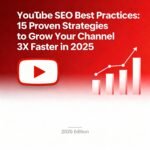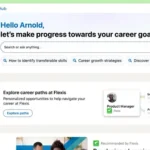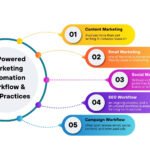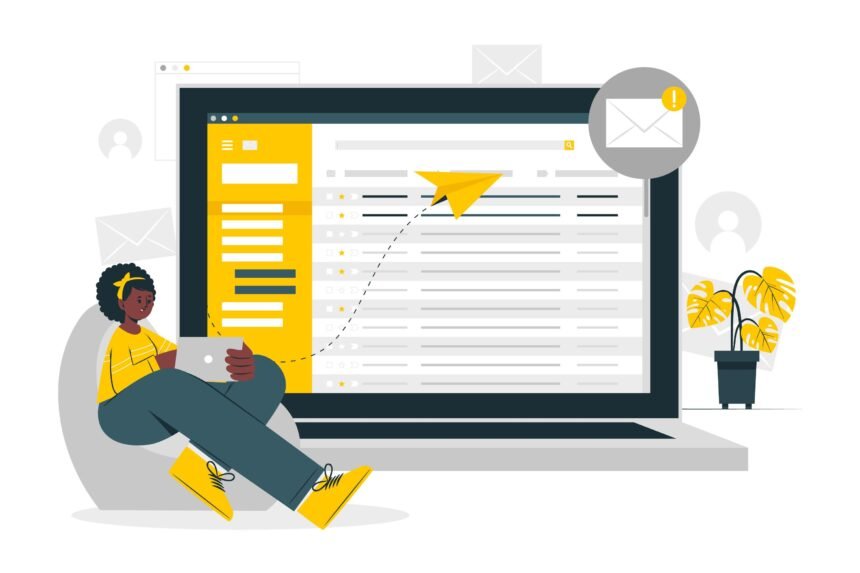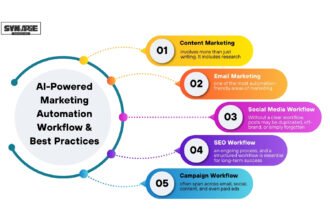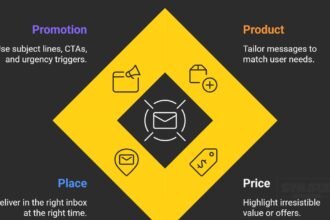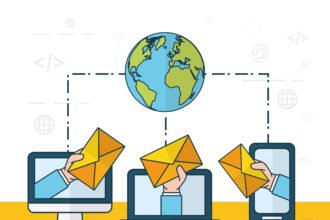You’ve probably asked yourself: how do I start email marketing? And you’re not alone. In a world dominated by viral videos, algorithm-chasing social posts, and fleeting trends, email remains the quiet powerhouse of digital marketing. Why? Because while feeds scroll past and reels fade, emails land directly where it matters most—your audience’s inbox.
Despite predictions of its demise year after year, email marketing has not just survived—it’s evolved. In 2025, it’s sharper, smarter, and more strategic than ever. With robust email marketing platforms, hyper-personalization tools, and data-driven customer engagement tactics, email gives you something most channels can’t: control, consistency, and measurable results.
What is Email Marketing Automation?
And if you’re wondering how do I start email marketing in a way that actually works—not just sends out random newsletters—then it starts with clarity of purpose. A strong email marketing strategy is built on well-defined marketing goals, deep audience insights, and campaigns that don’t just speak—but connect.
Whether you’re a solopreneur launching your first product or a growing brand looking to scale, this guide walks you through everything step-by-step. No jargon, no fluff—just a clear path to building your email empire.
Start with the Why: Define Clear Goals
Before you even draft your first email, pause and ask yourself: What am I trying to achieve? This might sound obvious, but it’s the foundation of every successful email marketing strategy. Without clear goals, your messages risk feeling scattered—and your subscribers will feel it too.
Are you aiming to boost sales, nurture leads, promote a product launch, or simply increase website traffic? Maybe you want to re-engage cold subscribers or onboard new users. Each objective demands a different tone, structure, and call to action (CTA). Knowing your destination helps you write with direction.
For instance, if your goal is lead nurturing, your campaign might focus on a value-packed email series that builds trust. On the other hand, if your aim is to drive sales, your emails will need urgency, compelling visuals, and laser-sharp CTAs like “Shop Now” or “Claim Your Offer.”
And here’s where the strategy clicks into place—your goals inform your email segmentation, your platform choice, and how you measure success through email marketing analytics. If you’ve been Googling how do I start email marketing, this is your starting line: Know what success looks like for you.
Know Your Audience Inside Out
If your goals are the “why,” then your audience is the “who”—and getting this right can make or break your entire email marketing strategy. Because let’s be honest, blasting the same message to your entire list is like throwing darts blindfolded. You might hit something… but you probably won’t.
So, how do I start email marketing with the right people in mind? You begin by building a clear picture of who your ideal subscribers are. That means going beyond surface-level demographics and diving into behavior—what they’ve clicked, bought, browsed, or ignored. Understanding their pain points, motivations, and stage in the buyer’s journey allows you to tailor emails that actually matter to them.
Let’s say you run an online wellness store. You wouldn’t send the same content to a first-time visitor and a repeat customer who’s abandoned their cart twice this week. Instead, you’d segment your list based on engagement, interests, or buying history, and create personalized campaigns for each group.
And here’s the beauty: most email marketing platforms (like Mailchimp or Adobe Campaign) make email segmentation easy and scalable. With just a few clicks, you can send hyper-targeted messages that feel less like marketing—and more like meaningful conversations.
Remember, the answer to how do I start email marketing isn’t just about sending emails. It’s about sending the right emails to the right people at the right time. That’s how you build customer engagement that lasts beyond the inbox.
Build a List That Actually Wants to Hear From You
Here’s a hard truth: buying email lists is like shouting into a crowd of strangers and expecting them to care. If you’re truly serious about getting email marketing right, your list needs to be built—not bought. So if you’re still wondering, how do I start email marketing?—you start by earning permission.
A high-quality list begins with opt-ins. That could mean sign-up forms on your website, popups offering a discount, lead magnets like free guides, or exclusive access to offers. The key? Give people a compelling reason to join your list—and make it clear what they’ll get in return.
Once they’re in, it’s not enough to treat everyone the same. This is where email list building evolves into email segmentation. You can group subscribers based on how they signed up, what pages they visited, their purchase behavior, or even their location. Someone who signed up for your “Beginner’s Guide to Investing” probably shouldn’t be getting your advanced portfolio strategies in their first week.
You’ll also need to keep things compliant. That means giving subscribers an easy way to opt out, being transparent about how you’ll use their data, and sticking to legal frameworks like GDPR or CAN-SPAM. Trust isn’t just good ethics—it’s good business.
A clean, engaged, and segmented list is one of your most valuable marketing assets. So next time someone asks you, how do I start email marketing?—you can answer confidently: with a permission-based list that’s built on value, not volume.
Choose the Right Email Marketing Platform
You’ve got goals. You’ve got an audience. You’ve even started building a list. Now you need the right tools to bring it all together—and that starts with choosing an email marketing platform that fits your needs and scales with your growth.
So when someone asks how do I start email marketing without getting overwhelmed by tech? The answer is: pick a platform that matches your level of experience and ambition.
For beginners or small businesses, tools like Mailchimp, MailerLite, or ConvertKit offer intuitive drag-and-drop editors, automation templates, and real-time analytics. If you’re running a mid-size or enterprise-level business, platforms like Adobe Campaign or HubSpot provide robust segmentation, advanced workflows, CRM integration, and AI-driven personalization.
Here’s what to look for in a platform:
- Ease of use: Can you build and send a campaign without needing a developer?
- Automation features: Does it support automated welcome emails, cart reminders, and post-purchase sequences?
- Email templates: Are there customizable, mobile-friendly options?
- Analytics dashboard: Can you track open rates, click-through rates, and conversions easily?
- Compliance tools: Built-in GDPR compliance and easy unsubscribe features matter more than ever.
Your email platform is your campaign command center. It handles everything from scheduling to list management to performance reporting. Choosing the wrong one can slow you down—or worse, frustrate your subscribers.
So if you’re asking yourself how do I start email marketing with confidence and control, it begins with choosing the platform that does more than just send emails. It should empower you to create, connect, analyze, and grow—without friction.
Segment Smart, Not Hard
If you want to know the real secret sauce behind high-performing email campaigns, it’s this: segmentation. It’s the difference between a one-size-fits-all newsletter that gets ignored—and a hyper-relevant message that gets opened, clicked, and acted on.
So when someone says, how do I start email marketing that people actually engage with? You tell them: start by sending the right message to the right person.
Email segmentation is about dividing your list into smaller, meaningful groups based on shared characteristics or behaviors. Think: new subscribers, repeat customers, people who haven’t opened an email in 60 days, or those who always click on product updates.
Here are a few smart ways to segment:
- Demographics: age, gender, location
- Behavioral triggers: past purchases, cart abandonment, email engagement
- Lifecycle stage: cold lead, active buyer, loyal customer
- Preferences: self-selected interests or content types
Why does this matter? Because segmented emails boost open rates, increase click-through rates, and dramatically improve conversions. People are far more likely to engage with content that feels like it was written just for them—and segmentation helps you do exactly that.
What is Email Marketing Automation?
Modern email marketing platforms make this easier than ever with automation rules and real-time analytics. You can create workflows that send different types of email campaign types (like welcome emails, re-engagement nudges, or product spotlights) to different segments automatically.
So, next time you find yourself asking how do I start email marketing that drives results—remember: segmentation isn’t optional. It’s essential. It’s how you stop talking at your list and start speaking to them.
Craft Content That Converts
So, your list is growing. Your segments are smart. But none of that matters if your emails fall flat once they land in the inbox. This is where content earns its keep—because when it comes to email, every word, image, and CTA counts.
Let’s start with the first impression: subject lines. This tiny line of text determines whether your email gets opened or ignored. The best ones are short, punchy, curiosity-driven, and keyword-rich. Use power verbs and emotional triggers. Subject lines like “Unlock Your 20% Discount” or “You Forgot Something in Your Cart” work because they speak directly to a reader’s intent.
Next up, the email body. You don’t need to be a copywriter to write great email content—but you do need to be clear. Start with a hook, deliver value fast, and close with a compelling call to action. Whether it’s “Shop Now,” “Read More,” or “Claim Your Bonus,” make sure the CTA stands out visually and emotionally.
And don’t underestimate design. Your emails need to be mobile-friendly, visually clean, and easy to scan. Use short paragraphs, clear headlines, buttons instead of links, and relevant images that enhance (not distract from) your message.
If you’re thinking how do I start email marketing that doesn’t just get read but actually converts, the answer lies here: email personalization and clear intent. Personalized greetings, product recommendations based on behavior, or dynamic content based on location can elevate a basic campaign into a high-performing one.
Pro tip? Keep your tone human. You’re not writing to a “list”—you’re writing to people. The more your emails feel like a conversation and less like a broadcast, the more your subscribers will look forward to hearing from you.
Remember: great email content isn’t about saying more. It’s about saying what matters—and saying it well.
A/B Test Everything—Seriously
Think of A/B testing as your behind-the-scenes cheat code for improving email performance. If you’ve ever wondered how do I start email marketing that’s backed by data, not guesswork—this is it.
A/B testing (also known as split testing) allows you to compare two versions of an email to see which one performs better. You send one version to a segment of your audience (Group A), and another slightly different version to another segment (Group B). Whichever version gets more opens, clicks, or conversions wins.
Here’s what you can (and should) test:
- Subject lines: Try different wordings, lengths, or tones
- CTA buttons: “Buy Now” vs. “Claim Your Offer”
- Email copy: Long-form vs. concise messaging
- Images: Product shot vs. lifestyle photo
- Send time: Tuesday at 9 AM vs. Thursday at 3 PM
Why does this matter? Because even small changes can lead to big results. One word in a subject line could boost your open rate by 20%. A bolder CTA button might double your click-through rate. The best part? You’re learning directly from your audience—no assumptions, just real behavior.
Most modern email marketing platforms come with built-in A/B testing tools that make it easy to set up experiments and analyze results. And as part of your ongoing email marketing strategy, testing helps refine your approach over time so your campaigns get sharper—and more profitable—with every send.
Bottom line: the question isn’t just how do I start email marketing, but how do I get better at it? A/B testing is how you stop guessing and start growing.
Stay Legal, Stay Trusted
You could have the catchiest subject line, the slickest design, and the smartest segmentation—but if you’re not playing by the rules, your emails could land in spam folders, damage your brand, or even get you fined.
So, when asking how do I start email marketing the right way, one of the first non-negotiables is compliance.
At the very least, your emails need to follow major regulations like:
- GDPR (General Data Protection Regulation) – applies if you have subscribers in the EU. You need explicit consent before emailing them, and a clear privacy policy.
- CAN-SPAM Act – in the U.S., this law requires that you clearly identify your email as promotional, provide your physical address, and include a simple way to unsubscribe.
- CASL (Canada’s Anti-Spam Legislation) – similar requirements, with an emphasis on obtaining express consent.
Now, that might sound overwhelming—but here’s the good news: most reputable email marketing platforms have tools built in to help you stay compliant. They automatically include unsubscribe links, give you fields to include your business address, and often help manage double opt-in processes.
Trust is currency in the inbox. If your subscribers feel you’re misusing their data or making it hard to opt out, they’ll either ignore you or mark you as spam—and that hurts your email deliverability across the board.
Being transparent about what people are signing up for, sending only what you promised, and making it easy to leave builds long-term credibility. So, if you’re asking how do I start email marketing that earns attention and respect—start by respecting your audience’s rights.
Because in 2025, inboxes are smarter. And so are the people reading them.
Analyze, Adjust, Repeat
So you’ve sent your first few campaigns—now what? You don’t just sit back and hope for the best. You dive into the numbers. Because the real magic of email marketing happens after you hit “send.”
If you’ve been asking how do I start email marketing that actually improves over time, this is the answer: analytics.
Start with the essentials:
- Open Rate – How many people opened your email? If this is low, revisit your subject line optimization or send time.
- Click-Through Rate (CTR) – Are readers clicking your links or CTAs? A low CTR may signal weak copy, confusing design, or poor alignment with user intent.
- Bounce Rate – If your emails aren’t getting delivered, your list quality may need cleanup.
- Conversion Rate – This is the big one. Are people taking the action you want—buying, booking, downloading?
Most email marketing platforms provide clear dashboards with these metrics, but the real power comes from interpretation. For example, if you notice subscribers from a particular segment have lower engagement, maybe your messaging doesn’t resonate. Or if your CTA is getting clicks but not conversions, perhaps your landing page needs work.
Also pay attention to unsubscribe rates. A small trickle is normal—but a spike could mean your content missed the mark, your frequency is too high, or you’re targeting the wrong segment.
And here’s the key: don’t just look at the data—act on it. Testing, tweaking, and iterating based on performance insights is what separates forgettable email marketers from the ones who dominate the inbox.
In short, how do I start email marketing that evolves and scales? You track. You learn. You optimize. Every campaign is a chance to get smarter—and better.
Personalization Is the New Standard
Gone are the days when dropping a subscriber’s first name into the subject line counted as “personalization.” In 2025, that’s just table stakes. If you’re still wondering how do I start email marketing that cuts through the noise and actually connects—this is where things get real.
Personalized email marketing is about using subscriber data—interests, past behavior, location, lifecycle stage—to deliver content that feels like it was written just for them. Think Netflix recommendations, Spotify playlists, or your favorite store remembering your size. That level of thoughtful targeting is now expected in the inbox, too.
Here’s how to level up:
- Dynamic content blocks: Show different products, images, or messages based on each user’s preferences or behavior.
- Behavioral triggers: Send emails based on actions like browsing history, cart activity, or downloads.
- Smart segmentation: Create micro-audiences like “high-value customers who haven’t purchased in 30 days.”
- Personalized subject lines and CTAs: “Hey Sarah, your skincare bundle is still waiting.”
Most advanced email marketing platforms (like Adobe Campaign or Klaviyo) make this easier than ever with built-in AI and automation. You can use their tools to create responsive, mobile-friendly emails that adapt in real time to subscriber behavior.
The result? Higher open rates, better click-through rates, and stronger brand loyalty. Because when people feel seen, they stick around—and they buy.
So if you’ve been asking how do I start email marketing that doesn’t just reach inboxes, but also hearts and wallets—personalization is your answer. It’s no longer a “nice-to-have.” It’s the expectation.
Time It Right: Seasonal and Triggered Campaigns
You could write the perfect email—but send it at the wrong time, and it’ll vanish into the inbox abyss. Timing, in email marketing, is everything. It’s what separates campaigns that get opened now from those that get buried under weekend promotions and unread newsletters.
So when asking how do I start email marketing that actually gets attention, don’t forget the when alongside the what.
Seasonal Campaigns
These are your big calendar moments—Black Friday, Valentine’s Day, Back-to-School, or even industry-specific dates. Planning your email marketing strategy around these seasons means you can craft content that’s timely, relevant, and aligned with what your audience already cares about.
But here’s the key: don’t just send generic “Holiday Sale” emails. Segment your list and tailor content accordingly. A long-time customer might get early access, while a new subscriber receives an onboarding offer wrapped in a festive theme.
Triggered Campaigns
Also known as behavioral or automated campaigns, these are emails that fire based on a user’s action—or inaction. Some examples:
- Welcome emails after sign-up
- Abandoned cart reminders
- Post-purchase follow-ups
- Birthday or anniversary rewards
- Re-engagement sequences after 60 days of no activity
Triggered campaigns are powerful because they’re perfectly timed and perfectly relevant. They’re automated, scalable, and feel incredibly personal—even if you’re sending them to thousands of people.
Modern email marketing platforms make it easy to create these automations using visual workflows and smart rules. You set it once, and it works in the background, building loyalty and conversions without you lifting a finger.
If you’ve been wondering how do I start email marketing that stays consistent without eating up your time—this is the move. Set your seasonal calendar, build smart triggers, and let automation do the heavy lifting.
Because the best email isn’t just well-written. It’s well-timed.
Keep Up with the Trends—or Get Left Behind
Email might be one of the oldest digital channels, but in 2025, it’s evolving faster than ever. So if you’re still stuck asking how do I start email marketing using methods from five years ago, you’re already behind.
Staying ahead means understanding where the inbox is headed—and building a strategy that moves with it.
Trend #1: AI-Driven Optimization
Today’s top email marketing platforms are more than sending tools—they’re smart systems. With built-in AI, they analyze user behavior, suggest subject lines, personalize send times, and even auto-generate content tailored to each segment. Think of it as having a strategist, copywriter, and analyst on autopilot.
Trend #2: Mobile-First Design is Non-Negotiable
More than 60% of emails are opened on mobile devices. That means clunky layouts, tiny buttons, or slow-loading images are instant turn-offs. Use mobile-friendly templates, concise messaging, and responsive design to meet users where they are—on the go.
Trend #3: Micro-Segmentation & Predictive Personalization
It’s not just about knowing your audience—it’s about anticipating them. Platforms now let you segment based on predictive behaviors like likelihood to purchase or churn. That means more targeted offers, fewer unsubscribes, and higher customer engagement.
Trend #4: Interactive Emails
Interactive elements like in-email surveys, carousels, countdown timers, and embedded videos keep users engaged without leaving the inbox. It turns passive reading into active clicking—which leads to better click-through rates and more conversions.
Trend #5: Privacy-First Marketing
With growing concerns around data privacy, brands are shifting toward transparent, consent-based email strategies. Clear opt-ins, visible preferences, and strong GDPR compliance aren’t just good practice—they’re what customers now expect.
So, how do I start email marketing that doesn’t feel outdated the moment it’s sent? You stay curious. You adapt. You keep testing, learning, and leveraging tools that are built for today’s inbox—not yesterday’s.
Because in 2025, staying still means falling behind. And the brands winning in email? They’re the ones moving forward—one smart send at a time.
Top Global Email Marketing Trends in 2025
|
Trend |
Description |
|
AI-Driven Hyper-Personalization & Predictive Analytics |
AI tools now tailor content and send times based on behavior, optimizing subject lines, automations, and copy—resulting in improved engagement and ROI. |
|
Interactive & AMP-Powered Emails |
Emails now include embedded quizzes, polls, carousels, live countdowns, forms, and even purchase options—all inside the inbox . |
|
Privacy-Centric Strategies & First-/Zero-Party Data |
With stricter laws like GDPR/CCPA, marketers are turning to preference centers, consent gathering, and user-submitted data (zero-party), while minimizing third-party tracking . |
|
Mobile-First & Accessible Design |
Over 70% of emails are opened on mobile; brands are adopting responsive layouts, accessible fonts/alt text, dark-mode compatibility, and inclusive design . |
|
Omnichannel Integration (Email + SMS + Social) |
Email campaigns are increasingly connected with SMS and social channels to support coherent customer journeys across multiple touchpoints . |
|
User-Generated Content (UGC) & Community Building |
Featuring real reviews, testimonials, and social posts within emails enhances trust, authenticity, and engagement . |
|
Voice-Activated Email Experiences |
Emerging support for voice commands: listening to, interacting with, and even responding to emails using virtual assistants like Alexa and Siri . |
|
Sustainable & Ethical Emailing |
Brands are reducing send frequency, simplifying email designs, leveraging renewable-powered servers, and highlighting eco-friendly values . |
|
Advanced Segmentation & Micro-Targeting |
Brands are leveraging detailed behavioral and predictive data to create micro-segments, delivering highly relevant content to each group . |
|
Real-Time Content Updates |
Live data inclusion—such as inventory levels, weather updates, or countdown timers—keeps emails fresh and engaging at the moment of open . |
These trends reflect a shift toward smarter, more interactive, ethical, and user-driven email campaigns. In 2025, marketers who combine AI precision with creativity, respect privacy, embrace inclusivity, and connect across channels will lead the inbox.
Let me know if you’d like real-world examples or tool recommendations for any of these trends!
References
- Adobe – Guide to Email Marketing
- Simplilearn – Email Marketing Tutorial for Beginners
- SendGrid – Email Marketing Best Practices for 2025
- Mailchimp – Getting Started with Email Marketing
- Campaign Monitor – Beginner’s Guide to Email Marketing
- GetResponse – Email Marketing for Beginners
- Netcore Cloud – Top Email Marketing Trends 2025
- Zapier – Free Email Marketing Tools and Automation
- HubSpot – State of Email Marketing
- Neil Patel – Beginner’s Guide to Email Marketing
- Zero Gravity Marketing – 2025 Email + SEO Integration
- CMO Insider x Business Insider – AI in Marketing at Cannes Lions 2025
- EmailToolTester – Comparison of Email Platforms
- Skrapp.io – Email Marketing & SEO Integration
- GTechME – How to Use LSI Keywords in Marketing
- Marketer Milk – Top Email Marketing Blogs
Conclusion: So… How Do I Start Email Marketing?
If you’ve made it this far, you’re no longer just asking how do I start email marketing?—you’re ready to own it.
Here’s your recap, boss-level style:
- Start with clear goals—what do you actually want your emails to achieve?
- Know your audience inside out—because relevance wins attention.
- Build an opt-in list—never buy one. Earn trust, don’t hijack it.
- Choose the right email platform—your tools shape your success.
- Master segmentation—talk to people, not to lists.
- Craft killer content—words, visuals, and CTAs that convert.
- Test everything—because guessing is for amateurs.
- Stay compliant—respect privacy and protect your brand.
- Analyze, tweak, repeat—data is your best friend.
- Go deep on personalization—generic is invisible.
- Plan seasonal and triggered campaigns—because timing is power.
- Watch the trends—and ride the wave, don’t chase it.
Email marketing isn’t dead—it’s dominant.
In 2025, inboxes are smarter. Users are savvier. But with the right strategy, tools, and mindset, you can cut through the noise and build campaigns that truly deliver.
What is Email Marketing Automation?
So, the next time someone asks how do I start email marketing?, you’ll know exactly what to say—and more importantly, exactly what to do.
Now go on—start sending like you mean it. 🚀
Frequently Asked Questions on How Do I Start Email Marketing?
How do I start email marketing if I’ve never done it before?
Start by defining your goals (e.g. lead nurturing or sales), choosing an email marketing platform, and building an opt-in list. From there, segment your audience, create relevant content, and monitor performance using email marketing analytics.
What’s the best email marketing platform for beginners?
Tools like Mailchimp, MailerLite, and ConvertKit are great for beginners thanks to their user-friendly interfaces, pre-built templates, and automation features. As you scale, platforms like Klaviyo or Adobe Campaign offer more advanced options.
How often should I send emails to my list?
There’s no universal answer—it depends on your industry and audience. Start with a consistent schedule (weekly or biweekly), then adjust based on engagement and feedback. Consistency matters more than frequency.
What are the essential components of a strong email marketing strategy?
A strong email marketing strategy includes audience segmentation, goal-oriented campaigns, personalized content, A/B testing, mobile-friendly design, and clear CTAs—along with continuous measurement and optimization.
Is buying an email list a good idea?
No. Purchased lists often result in low engagement, high bounce rates, and damage to your sender reputation. Focus instead on email list building through opt-ins, lead magnets, and value-based content.
How do I make sure my emails don’t go to spam?
Use a reputable platform, avoid spammy language (“Buy now!!!”), always get permission before emailing, and include a clear unsubscribe option. Following GDPR and CAN-SPAM regulations is crucial for inbox placement and trust.
What are some examples of effective email campaign types?
Great campaigns include welcome emails, newsletters, product launch announcements, cart abandonment reminders, and re-engagement emails. Each has a specific purpose in driving customer engagement and conversions.
How important is email personalization?
Crucial. Personalized emails (based on behavior, interests, or purchase history) can dramatically improve open rates, click-through rates, and revenue. Today’s audiences expect content that feels tailored to them.
What’s the difference between email segmentation and personalization?
Segmentation is grouping subscribers based on shared data (like location or activity), while personalization uses that data to craft messages specific to each individual. Both work best when used together.
How do I track success in my email campaigns?
Monitor metrics like open rates, click-through rates, conversion rates, unsubscribe rates, and bounce rates. Use these insights to improve your next campaign and fine-tune your strategy over time.


